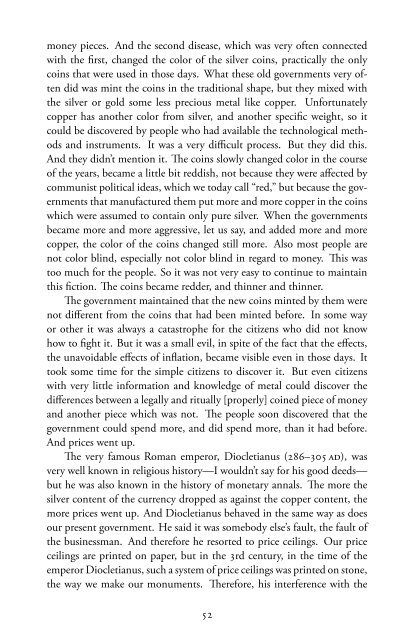Ludwig von Mises on Money and Inflation.pdf - The Ludwig von ...
Ludwig von Mises on Money and Inflation.pdf - The Ludwig von ...
Ludwig von Mises on Money and Inflation.pdf - The Ludwig von ...
You also want an ePaper? Increase the reach of your titles
YUMPU automatically turns print PDFs into web optimized ePapers that Google loves.
m<strong>on</strong>ey pieces. And the sec<strong>on</strong>d disease, which was very often c<strong>on</strong>nected<br />
with the first, changed the color of the silver coins, practically the <strong>on</strong>ly<br />
coins that were used in those days. What these old governments very often<br />
did was mint the coins in the traditi<strong>on</strong>al shape, but they mixed with<br />
the silver or gold some less precious metal like copper. Unfortunately<br />
copper has another color from silver, <strong>and</strong> another specific weight, so it<br />
could be discovered by people who had available the technological methods<br />
<strong>and</strong> instruments. It was a very difficult process. But they did this.<br />
And they didn’t menti<strong>on</strong> it. e coins slowly changed color in the course<br />
of the years, became a little bit reddish, not because they were affected by<br />
communist political ideas, which we today call “red,” but because the governments<br />
that manufactured them put more <strong>and</strong> more copper in the coins<br />
which were assumed to c<strong>on</strong>tain <strong>on</strong>ly pure silver. When the governments<br />
became more <strong>and</strong> more aggressive, let us say, <strong>and</strong> added more <strong>and</strong> more<br />
copper, the color of the coins changed still more. Also most people are<br />
not color blind, especially not color blind in regard to m<strong>on</strong>ey. is was<br />
too much for the people. So it was not very easy to c<strong>on</strong>tinue to maintain<br />
this ficti<strong>on</strong>. e coins became redder, <strong>and</strong> thinner <strong>and</strong> thinner.<br />
e government maintained that the new coins minted by them were<br />
not different from the coins that had been minted before. In some way<br />
or other it was always a catastrophe for the citizens who did not know<br />
how to fight it. But it was a small evil, in spite of the fact that the effects,<br />
the unavoidable effects of inflati<strong>on</strong>, became visible even in those days. It<br />
took some time for the simple citizens to discover it. But even citizens<br />
with very little informati<strong>on</strong> <strong>and</strong> knowledge of metal could discover the<br />
differences between a legally <strong>and</strong> ritually [properly] coined piece of m<strong>on</strong>ey<br />
<strong>and</strong> another piece which was not. e people so<strong>on</strong> discovered that the<br />
government could spend more, <strong>and</strong> did spend more, than it had before.<br />
And prices went up.<br />
e very famous Roman emperor, Diocletianus (286–305 AD), was<br />
very well known in religious history—I wouldn’t say for his good deeds—<br />
but he was also known in the history of m<strong>on</strong>etary annals. e more the<br />
silver c<strong>on</strong>tent of the currency dropped as against the copper c<strong>on</strong>tent, the<br />
more prices went up. And Diocletianus behaved in the same way as does<br />
our present government. He said it was somebody else’s fault, the fault of<br />
the businessman. And therefore he resorted to price ceilings. Our price<br />
ceilings are printed <strong>on</strong> paper, but in the 3rd century, in the time of the<br />
emperor Diocletianus, such a system of price ceilings was printed <strong>on</strong> st<strong>on</strong>e,<br />
the way we make our m<strong>on</strong>uments. erefore, his interference with the<br />
52

















